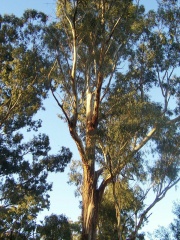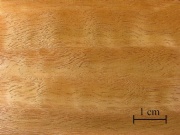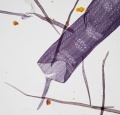Difference between revisions of "Eucalyptus"
JMcGlinchey (talk | contribs) |
|||
| (4 intermediate revisions by 3 users not shown) | |||
| Line 1: | Line 1: | ||
| − | [[File: | + | [[File:Eucalyptustreevt.jpg|thumb|Eucalyptus tree ''(Eucalyptus spp.)'']] |
| − | |||
| − | ''(Eucalyptus spp.)'']] | ||
== Description == | == Description == | ||
| − | + | [[File:Image3_802427.jpg|thumb|Eucalyptus ''(Eucalyptus spp.)'']] | |
Over 700 evergreen tree species belong to the genus ''Eucalyptus''. They are native to Australia but are now grown in many subtropical locations around the world (California, Spain, South America, India, South Africa, etc.). Eucalyptus wood is used for construction, papermaking pulp, inexpensive furniture and small turned items such as paintbrush handles. Most eucalyptus wood is durable but not dimensionally stable. The bark from the trees, however, is high in tannins and is used on a large scale for leather production. Most commonly used tannins are obtained from [[maletto bark]] (''E. astringens'') and mugga or [[red iron bark]] (''E. sideroxylon''). These tend to produce a dark red leather and are sometimes mixed with other tannins. [[Eucalyptus oil]] is obtained from the dry leaves of several species of eucalyptus trees especially ''E. salicifolia'' and ''E. globulus'' (blue gum). | Over 700 evergreen tree species belong to the genus ''Eucalyptus''. They are native to Australia but are now grown in many subtropical locations around the world (California, Spain, South America, India, South Africa, etc.). Eucalyptus wood is used for construction, papermaking pulp, inexpensive furniture and small turned items such as paintbrush handles. Most eucalyptus wood is durable but not dimensionally stable. The bark from the trees, however, is high in tannins and is used on a large scale for leather production. Most commonly used tannins are obtained from [[maletto bark]] (''E. astringens'') and mugga or [[red iron bark]] (''E. sideroxylon''). These tend to produce a dark red leather and are sometimes mixed with other tannins. [[Eucalyptus oil]] is obtained from the dry leaves of several species of eucalyptus trees especially ''E. salicifolia'' and ''E. globulus'' (blue gum). | ||
| − | |||
| − | |||
| − | |||
| − | |||
== Synonyms and Related Terms == | == Synonyms and Related Terms == | ||
| Line 14: | Line 8: | ||
gumwood; white mountain ash; eucalyptus (Fr., Sven.); Eukalyptus (Deut.); eucalipto (It.); eucalipto (Esp., Port.); eucalyptusboom (Ned.); eukaliptus (Pol.); Tasmanian oak (''Eucalyptus regnans''); blue gum (''Eucalyptus globulus''); red iron bark (''Eucalyptus sideroxylon''); maletto bark (''Eucalyptus astringens'') | gumwood; white mountain ash; eucalyptus (Fr., Sven.); Eukalyptus (Deut.); eucalipto (It.); eucalipto (Esp., Port.); eucalyptusboom (Ned.); eukaliptus (Pol.); Tasmanian oak (''Eucalyptus regnans''); blue gum (''Eucalyptus globulus''); red iron bark (''Eucalyptus sideroxylon''); maletto bark (''Eucalyptus astringens'') | ||
| − | == | + | == Physical and Chemical Properties == |
| − | |||
| − | |||
| − | + | * Color: light brown. | |
| − | + | * Rings: distinct. | |
| − | + | * Pores: distinct, coarse. | |
| − | + | * Grain: distinct. | |
| − | + | * Rays: obscure. | |
| − | + | * Hard, heavy wood. | |
| − | + | * Density = 42 ppcf | |
| − | + | * Specific gravity = 0.67 | |
| − | Paper fiber type: Hardwood. Using transmitted light microscopy, fibers are short and thin, with some pitted | + | Paper fiber type: Hardwood. Using transmitted light microscopy, fibers are short and thin, with some pitted tracheid fibers. Large, oblong vessel elements with long tails are present. Vessels have oval to round ray parenchyma pits in horizontal rows. Vasocentric trachieds are also present. Appearance with [[Graff "C" stain]]: varies with bleaching. Average dimensions of fibers: length 1.1mm, width 20μm. Common pulping method: [[kraft process|kraft]]. |
== Additional Images == | == Additional Images == | ||
<gallery> | <gallery> | ||
| − | File:34_Blue | + | File:34_Blue Gum_100x_Tan.jpg|thumb|Blue gum (''Eucalyptus globulus''); tangential cross-section at 100x |
| − | File:34_Blue | + | File:34_Blue Gum_100x_Rad.jpg|Blue gum (''Eucalyptus globulus''); radial cross-section at 100x |
| − | File: | + | File:34_Blue Gum_100x_Tran.jpg|Blue gum (''Eucalyptus globulus''); transverse cross-section at 100x |
File:Euc vessel 40x.jpg|Eucalyptus pulp stained with Graff "C" Stain | File:Euc vessel 40x.jpg|Eucalyptus pulp stained with Graff "C" Stain | ||
</gallery> | </gallery> | ||
| − | == | + | == Resources and Citations == |
* G.S.Brady, ''Materials Handbook'', McGraw-Hill Book Co., New York, 1971 Comment: p. 382 | * G.S.Brady, ''Materials Handbook'', McGraw-Hill Book Co., New York, 1971 Comment: p. 382 | ||
| Line 48: | Line 40: | ||
* E.J.LaBarre, ''Dictionary and Encyclopedia of Paper and Paper-making'', Swets & Zeitlinger, Amsterdam, 1969 | * E.J.LaBarre, ''Dictionary and Encyclopedia of Paper and Paper-making'', Swets & Zeitlinger, Amsterdam, 1969 | ||
| − | * ''Encyclopedia Britannica'', http://www.britannica.com Comment: "Eucalyptus." | + | * ''Encyclopedia Britannica'', http://www.britannica.com Comment: "Eucalyptus." EAccessed 7 Apr. 2005 . |
* H.L.Edlin, ''What Wood is That?'', Viking Press, New York, 1969 | * H.L.Edlin, ''What Wood is That?'', Viking Press, New York, 1969 | ||
| − | * Wikipedia | + | * Wikipedia: http://en.wikipedia.org/wiki/Eucalyptus (Accessed Dec. 9, 2005) |
* ''Van Nostrand's Scientific Encyclopedia'', Douglas M. Considine (ed.), Van Nostrand Reinhold, New York, 1976 | * ''Van Nostrand's Scientific Encyclopedia'', Douglas M. Considine (ed.), Van Nostrand Reinhold, New York, 1976 | ||
Latest revision as of 15:45, 5 August 2022
Description
Over 700 evergreen tree species belong to the genus Eucalyptus. They are native to Australia but are now grown in many subtropical locations around the world (California, Spain, South America, India, South Africa, etc.). Eucalyptus wood is used for construction, papermaking pulp, inexpensive furniture and small turned items such as paintbrush handles. Most eucalyptus wood is durable but not dimensionally stable. The bark from the trees, however, is high in tannins and is used on a large scale for leather production. Most commonly used tannins are obtained from Maletto bark (E. astringens) and mugga or Red iron bark (E. sideroxylon). These tend to produce a dark red leather and are sometimes mixed with other tannins. Eucalyptus oil is obtained from the dry leaves of several species of eucalyptus trees especially E. salicifolia and E. globulus (blue gum).
Synonyms and Related Terms
gumwood; white mountain ash; eucalyptus (Fr., Sven.); Eukalyptus (Deut.); eucalipto (It.); eucalipto (Esp., Port.); eucalyptusboom (Ned.); eukaliptus (Pol.); Tasmanian oak (Eucalyptus regnans); blue gum (Eucalyptus globulus); red iron bark (Eucalyptus sideroxylon); maletto bark (Eucalyptus astringens)
Physical and Chemical Properties
- Color: light brown.
- Rings: distinct.
- Pores: distinct, coarse.
- Grain: distinct.
- Rays: obscure.
- Hard, heavy wood.
- Density = 42 ppcf
- Specific gravity = 0.67
Paper fiber type: Hardwood. Using transmitted light microscopy, fibers are short and thin, with some pitted tracheid fibers. Large, oblong vessel elements with long tails are present. Vessels have oval to round ray parenchyma pits in horizontal rows. Vasocentric trachieds are also present. Appearance with Graff "C" stain: varies with bleaching. Average dimensions of fibers: length 1.1mm, width 20μm. Common pulping method: kraft.
Additional Images
Resources and Citations
- G.S.Brady, Materials Handbook, McGraw-Hill Book Co., New York, 1971 Comment: p. 382
- Matt Roberts, Don Etherington, Bookbinding and the Conservation of Books: a Dictionary of Descriptive Terminology, U.S. Government Printing Office, Washington DC, 1982
- The Dictionary of Paper, American Paper Institute, New York, Fourth Edition, 1980
- E.J.LaBarre, Dictionary and Encyclopedia of Paper and Paper-making, Swets & Zeitlinger, Amsterdam, 1969
- Encyclopedia Britannica, http://www.britannica.com Comment: "Eucalyptus." EAccessed 7 Apr. 2005 .
- H.L.Edlin, What Wood is That?, Viking Press, New York, 1969
- Wikipedia: http://en.wikipedia.org/wiki/Eucalyptus (Accessed Dec. 9, 2005)
- Van Nostrand's Scientific Encyclopedia, Douglas M. Considine (ed.), Van Nostrand Reinhold, New York, 1976
- Random House, Webster's Encyclopedic Unabridged Dictionary of the English Language, Grammercy Book, New York, 1997
- Marja-Sisko Ilvessalo-Pfäffli. Fiber Atlas: Identification of Papermaking Fibers (Springer Series in Wood Science). Springer, 1995.
- Walter Rantanen. "Fiber ID Course." Integrated Paper Services. June 2013. Lecture.





